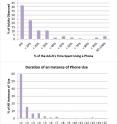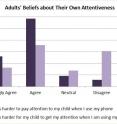Study: 44 percent of parents struggle to limit cell phone use at playgrounds
A new University of Washington study finds that cell phone use at playgrounds is a significant source of parental guilt, as well as a powerful distraction when children try to get caregivers' attention or ask to them to watch a monkey bar trick for the hundredth time. The largest group of parents, nannies and adult babysitters -- 44 percent -- felt they ought to restrict cell phone use while watching children at playgrounds but felt guilty for failing to live up to those ideals, researchers found. They also observed that caregivers absorbed in their phones were much less attentive to children's requests than when they were chatting with friends or caring for other children.
The most common mobile phone uses on playgrounds were texting with friends and family, taking pictures and emailing. Only 28 percent of caregivers reported using their phones to do work, and there was no appreciable difference in mobile phone use between male and female caregivers.
The study, presented last month at the Association for Computing Machinery's CHI 2015 conference in Seoul, Korea, documented more than 40 hours of interactions at playgrounds in north Seattle and collected data from 466 adult caregivers. While other studies have anonymously observed parental cell phone use at playgrounds and fast food restaurants, this is the first to also interview parents, nannies and others about their phone use while caring for children in public places.
"Concerns on this topic are very prevalent, and a lot of people report feeling guilty about their own behaviors," said lead author Alexis Hiniker, a doctoral student in the UW's human centered design and engineering department. "But there's also a group who resents the idea that they should have to put their phones away when their child is safe and happily engaged in something else. There were strong opinions and very divergent opinions, for sure."
The researchers found that boredom often trumped guilt or fear of being judged and was the single biggest driver prompting people to dig cell phones out of their pockets or purses.
The study also found that adults commonly overestimated how responsive they were to children's requests while using their phones. Many parents recognized that being absorbed in their phone dilutes their attention, but many also believed that a child's request to push them on the swing or settle a dispute readily drew them back into the present moment.
Yet in 32 instances when researchers observed a child trying to interrupt an adult using a cell phone, the caregiver completely failed to respond, speak or look away from the phone 56 percent of the time.
That level of absorption was unusual compared to other activities. In 70 instances when a child tried to get the attention of a caregiver who was chatting with a friend, helping a sibling or simply staring into space, only 11 percent of those adults failed to respond to the child's request.
On the other hand, the total amount of observed cell phone use in Seattle playgrounds was relatively low. Nearly two-thirds of caregivers spent less than 5 percent of their time at the park using a phone, and many phone interactions lasted less than 10 seconds.
"Phones do distract us and that's something to be aware of, but I think it's not nearly as bad as some people have made things out to be," said co-author Julie Kientz, associate professor of human centered design and engineering and director of the UW Computing for Healthy Living and Learning Lab. "Plenty of people are being really attentive parents and thinking deeply about these issues."
Indeed, caregivers reported using their phones twice as often for childcare-related activities such as taking pictures to share with spouses or grandparents (88 percent), arranging to meet people later in the day (79 percent) or checking the time (75 percent). Adults generally felt less guilty about these types of activities compared to working (28 percent) or playing games (5 percent), even though the child-related phone use may be just as distracting.
Caregivers generally fell into three camps: Those who felt it was completely appropriate to engage in adult-focused activities like checking email or reading on their phones while children are engaged in playground activities (28 percent), those who felt it was important to eliminate or minimize their own phone use while watching children and lived up to those ideals (24 percent) and those who felt they should restrict phone use but weren't able to do so (44 percent).
The fact that the largest group of caregivers had misgivings about smartphone absorption while parenting suggests that phone and app designers might consider making it easier for some users to disengage, researchers said. Tools like a "parenting" mode with limited functionality, scrolling options that end after five or 10 items or even a simple password screen can create natural breaks that prompt users check in with the outside world.
"The more we bring every type of computing experience with us everywhere, the more sophisticated designers are going to have to be," Hiniker said. "If users experience technology as so attention-grabby that they can't maintain the balanced life experience that they want, then they're going to turn away."
Source: University of Washington
Other sources
- Parents who use cellphones on playgrounds feel guilty, study findsfrom PhysorgFri, 22 May 2015, 1:00:20 UTC
- Parents struggle to limit cell phone use at playgroundsfrom Science BlogTue, 19 May 2015, 12:30:22 UTC
- 44 percent of parents struggle to limit cell phone use at playgroundsfrom Science DailyMon, 18 May 2015, 23:50:23 UTC
- Nearly half of all parents feel guilty about playground cell phone usefrom UPIMon, 18 May 2015, 21:20:21 UTC
- 44 percent of parents struggle to limit cell phone use at playgroundsfrom PhysorgMon, 18 May 2015, 20:22:46 UTC

